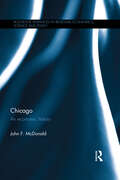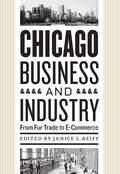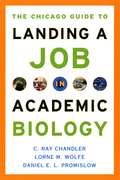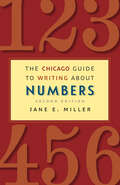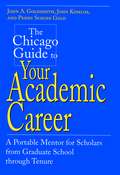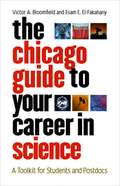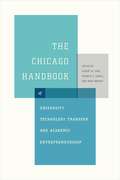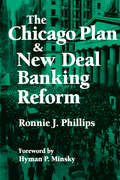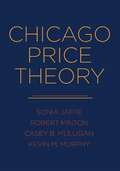- Table View
- List View
Chicago: An economic history (Routledge Advances in Regional Economics, Science and Policy)
by John F. McDonaldChicago went from nothing in 1830 to become the second-largest city in the nation in 1900, while the Midwest developed to become one of the world’s foremost urban areas. This book is an economic history of the Chicago metropolitan area from the 1820s to the present. It examines the city in its Midwestern region and compares it to the other major cities of the North. This book uses theories of the economics of location and other economic models to explain much of Chicago’s history. Chicago maintained its status as the second-largest city through the first decades of the 20th century, but rapid growth shifted to the Sunbelt following World War II. Since the 1950s the city’s history can be divided into four distinct periods; growth with suburbanization (1950-1970), absence of growth, continued suburbanization, and central city crisis (1970-1990), rebound in the 1990s, and financial crisis and deep recession after 2000. Through it all Chicago has maintained its position as the economic capital of the Midwest. The book is a synthesis of available literature and public data, and stands as an example of using economics to understand much of the history of Chicago. This book is intended for the college classroom, urban scholars, and for those interested in the history of one of world’s foremost urban areas.
Chicago: An economic history (Routledge Advances in Regional Economics, Science and Policy)
by John F. McDonaldChicago went from nothing in 1830 to become the second-largest city in the nation in 1900, while the Midwest developed to become one of the world’s foremost urban areas. This book is an economic history of the Chicago metropolitan area from the 1820s to the present. It examines the city in its Midwestern region and compares it to the other major cities of the North. This book uses theories of the economics of location and other economic models to explain much of Chicago’s history. Chicago maintained its status as the second-largest city through the first decades of the 20th century, but rapid growth shifted to the Sunbelt following World War II. Since the 1950s the city’s history can be divided into four distinct periods; growth with suburbanization (1950-1970), absence of growth, continued suburbanization, and central city crisis (1970-1990), rebound in the 1990s, and financial crisis and deep recession after 2000. Through it all Chicago has maintained its position as the economic capital of the Midwest. The book is a synthesis of available literature and public data, and stands as an example of using economics to understand much of the history of Chicago. This book is intended for the college classroom, urban scholars, and for those interested in the history of one of world’s foremost urban areas.
Chicago Business and Industry: From Fur Trade to E-Commerce
by Janice L. ReiffFrom its humble beginnings as a fur-trading outpost, Chicago has become one of the foremost centers of world finance and trade. With its blue-collar work ethic and an economic history that extends into virtually every segment of American industry, it certainly lives up to its moniker as the City That Works. Drawing on the award-winning Encyclopedia of Chicago, Janice L. Reiff has compiled a unique history of work in the Windy City. Beginning with an overview of the city’s commercial development, Chicago Business and Industry considers how key industries shaped—and were shaped by—both the local and global economies. The city’s phenomenal population growth, its proximity to water, and its development of railroads made Chicago one of the most productive markets for lumber and grain throughout the nineteenth century. The region’s once-booming steel industry, on the other hand, suffered a dramatic decline in the second half of the twentieth century, when already weakened demand met with increasing international competition. Chicago Business and Industry chronicles the Chicago region’s changing fortunes from its beginning. Reiff has compiled and updated essays from the Encyclopedia covering the city’s most historically famous—and infamous—companies, from the Union Stock Yard to Montgomery Ward to the Board of Trade. The book concludes with a historical account of labor types and issues in the city, with attention to such topics as health-care workers, unemployment, and unionization. Today, Groupon and a host of other high-tech firms have led some experts to christen Chicago the Silicon Valley of the Midwest. Reiff’s new introduction takes account of these and other recent trends. Engaging, accessible, and packed with fascinating facts, Chicago Business and Industry invites readers into the history and diversity of work in the city, helping them understand how Chicago became Chicago.
The Chicago Guide to Landing a Job in Academic Biology (Chicago Guides to Academic Life)
by C. Ray Chandler Lorne M. Wolfe Daniel E. PromislowThe Chicago Guide to Landing a Job in Academic Biology is an indispensable guide for graduate students and post-docs as they enter that domain red in tooth and claw: the job market. An academic career in the biological sciences typically demands well over a decade of technical training. So it’s ironic that when a scholar reaches the most critical stage in that career—the search for a job following graduate work—he or she receives little or no formal preparation. Instead, students are thrown into the job market with only cursory guidance on how to search for and land a position. Now there’s help. Carefully, clearly, and with a welcome sense of humor, The Chicago Guide to Landing a Job in Academic Biology leads graduate students and postdoctoral fellows through the perils and rewards of their first job search. The authors—who collectively have for decades mentored students and served on hiring committees—have honed their advice in workshops at biology meetings across the country. The resulting guide covers everything from how to pack an overnight bag without wrinkling a suit to selecting the right job to apply for in the first place. The authors have taken care to make their advice useful to all areas of academic biology—from cell biology and molecular genetics to evolution and ecology—and they give tips on how applicants can tailor their approaches to different institutions from major research universities to small private colleges. With jobs in the sciences ever more difficult to come by, The Chicago Guide to Landing a Job in Academic Biology is designed to help students and post-docs navigate the tricky terrain of an academic job search—from the first year of a graduate program to the final negotiations of a job offer.
The Chicago Guide to Landing a Job in Academic Biology (Chicago Guides to Academic Life)
by C. Ray Chandler Lorne M. Wolfe Daniel E. PromislowThe Chicago Guide to Landing a Job in Academic Biology is an indispensable guide for graduate students and post-docs as they enter that domain red in tooth and claw: the job market. An academic career in the biological sciences typically demands well over a decade of technical training. So it’s ironic that when a scholar reaches the most critical stage in that career—the search for a job following graduate work—he or she receives little or no formal preparation. Instead, students are thrown into the job market with only cursory guidance on how to search for and land a position. Now there’s help. Carefully, clearly, and with a welcome sense of humor, The Chicago Guide to Landing a Job in Academic Biology leads graduate students and postdoctoral fellows through the perils and rewards of their first job search. The authors—who collectively have for decades mentored students and served on hiring committees—have honed their advice in workshops at biology meetings across the country. The resulting guide covers everything from how to pack an overnight bag without wrinkling a suit to selecting the right job to apply for in the first place. The authors have taken care to make their advice useful to all areas of academic biology—from cell biology and molecular genetics to evolution and ecology—and they give tips on how applicants can tailor their approaches to different institutions from major research universities to small private colleges. With jobs in the sciences ever more difficult to come by, The Chicago Guide to Landing a Job in Academic Biology is designed to help students and post-docs navigate the tricky terrain of an academic job search—from the first year of a graduate program to the final negotiations of a job offer.
The Chicago Guide to Landing a Job in Academic Biology (Chicago Guides to Academic Life)
by C. Ray Chandler Lorne M. Wolfe Daniel E. PromislowThe Chicago Guide to Landing a Job in Academic Biology is an indispensable guide for graduate students and post-docs as they enter that domain red in tooth and claw: the job market. An academic career in the biological sciences typically demands well over a decade of technical training. So it’s ironic that when a scholar reaches the most critical stage in that career—the search for a job following graduate work—he or she receives little or no formal preparation. Instead, students are thrown into the job market with only cursory guidance on how to search for and land a position. Now there’s help. Carefully, clearly, and with a welcome sense of humor, The Chicago Guide to Landing a Job in Academic Biology leads graduate students and postdoctoral fellows through the perils and rewards of their first job search. The authors—who collectively have for decades mentored students and served on hiring committees—have honed their advice in workshops at biology meetings across the country. The resulting guide covers everything from how to pack an overnight bag without wrinkling a suit to selecting the right job to apply for in the first place. The authors have taken care to make their advice useful to all areas of academic biology—from cell biology and molecular genetics to evolution and ecology—and they give tips on how applicants can tailor their approaches to different institutions from major research universities to small private colleges. With jobs in the sciences ever more difficult to come by, The Chicago Guide to Landing a Job in Academic Biology is designed to help students and post-docs navigate the tricky terrain of an academic job search—from the first year of a graduate program to the final negotiations of a job offer.
The Chicago Guide to Writing about Numbers, Second Edition (Chicago Guides to Writing, Editing, and Publishing)
by Jane E. MillerEarning praise from scientists, journalists, faculty, and students, The Chicago Guide to Writing about Numbers has helped thousands of writers communicate data clearly and effectively. Its publication offered a much-needed bridge between good quantitative analysis and clear expository writing, using straightforward principles and efficient prose. With this new edition, Jane Miller draws on a decade of additional experience and research, expanding her advice on reaching everyday audiences and further integrating non-print formats. Miller, an experienced teacher of research methods, statistics, and research writing, opens by introducing a set of basic principles for writing about numbers, then presents a toolkit of techniques that can be applied to prose, tables, charts, and presentations. Throughout the book, she emphasizes flexibility, showing writers that different approaches work for different kinds of data and different types of audiences. The second edition adds a chapter on writing about numbers for lay audiences, explaining how to avoid overwhelming readers with jargon and technical issues. Also new is an appendix comparing the contents and formats of speeches, research posters, and papers, to teach writers how to create all three types of communication without starting each from scratch. An expanded companion website includes new multimedia resources such as slide shows and podcasts that illustrate the concepts and techniques, along with an updated study guide of problem sets and suggested course extensions. This continues to be the only book that brings together all the tasks that go into writing about numbers, integrating advice on finding data, calculating statistics, organizing ideas, designing tables and charts, and writing prose all in one volume. Field-tested with students and professionals alike, this holistic book is the go-to guide for everyone who writes or speaks about numbers.
The Chicago Guide to Writing about Numbers, Second Edition (Chicago Guides to Writing, Editing, and Publishing)
by Jane E. MillerEarning praise from scientists, journalists, faculty, and students, The Chicago Guide to Writing about Numbers has helped thousands of writers communicate data clearly and effectively. Its publication offered a much-needed bridge between good quantitative analysis and clear expository writing, using straightforward principles and efficient prose. With this new edition, Jane Miller draws on a decade of additional experience and research, expanding her advice on reaching everyday audiences and further integrating non-print formats. Miller, an experienced teacher of research methods, statistics, and research writing, opens by introducing a set of basic principles for writing about numbers, then presents a toolkit of techniques that can be applied to prose, tables, charts, and presentations. Throughout the book, she emphasizes flexibility, showing writers that different approaches work for different kinds of data and different types of audiences. The second edition adds a chapter on writing about numbers for lay audiences, explaining how to avoid overwhelming readers with jargon and technical issues. Also new is an appendix comparing the contents and formats of speeches, research posters, and papers, to teach writers how to create all three types of communication without starting each from scratch. An expanded companion website includes new multimedia resources such as slide shows and podcasts that illustrate the concepts and techniques, along with an updated study guide of problem sets and suggested course extensions. This continues to be the only book that brings together all the tasks that go into writing about numbers, integrating advice on finding data, calculating statistics, organizing ideas, designing tables and charts, and writing prose all in one volume. Field-tested with students and professionals alike, this holistic book is the go-to guide for everyone who writes or speaks about numbers.
The Chicago Guide to Writing about Numbers, Second Edition (Chicago Guides to Writing, Editing, and Publishing)
by Jane E. MillerEarning praise from scientists, journalists, faculty, and students, The Chicago Guide to Writing about Numbers has helped thousands of writers communicate data clearly and effectively. Its publication offered a much-needed bridge between good quantitative analysis and clear expository writing, using straightforward principles and efficient prose. With this new edition, Jane Miller draws on a decade of additional experience and research, expanding her advice on reaching everyday audiences and further integrating non-print formats. Miller, an experienced teacher of research methods, statistics, and research writing, opens by introducing a set of basic principles for writing about numbers, then presents a toolkit of techniques that can be applied to prose, tables, charts, and presentations. Throughout the book, she emphasizes flexibility, showing writers that different approaches work for different kinds of data and different types of audiences. The second edition adds a chapter on writing about numbers for lay audiences, explaining how to avoid overwhelming readers with jargon and technical issues. Also new is an appendix comparing the contents and formats of speeches, research posters, and papers, to teach writers how to create all three types of communication without starting each from scratch. An expanded companion website includes new multimedia resources such as slide shows and podcasts that illustrate the concepts and techniques, along with an updated study guide of problem sets and suggested course extensions. This continues to be the only book that brings together all the tasks that go into writing about numbers, integrating advice on finding data, calculating statistics, organizing ideas, designing tables and charts, and writing prose all in one volume. Field-tested with students and professionals alike, this holistic book is the go-to guide for everyone who writes or speaks about numbers.
The Chicago Guide to Writing about Numbers, Second Edition (Chicago Guides to Writing, Editing, and Publishing)
by Jane E. MillerEarning praise from scientists, journalists, faculty, and students, The Chicago Guide to Writing about Numbers has helped thousands of writers communicate data clearly and effectively. Its publication offered a much-needed bridge between good quantitative analysis and clear expository writing, using straightforward principles and efficient prose. With this new edition, Jane Miller draws on a decade of additional experience and research, expanding her advice on reaching everyday audiences and further integrating non-print formats. Miller, an experienced teacher of research methods, statistics, and research writing, opens by introducing a set of basic principles for writing about numbers, then presents a toolkit of techniques that can be applied to prose, tables, charts, and presentations. Throughout the book, she emphasizes flexibility, showing writers that different approaches work for different kinds of data and different types of audiences. The second edition adds a chapter on writing about numbers for lay audiences, explaining how to avoid overwhelming readers with jargon and technical issues. Also new is an appendix comparing the contents and formats of speeches, research posters, and papers, to teach writers how to create all three types of communication without starting each from scratch. An expanded companion website includes new multimedia resources such as slide shows and podcasts that illustrate the concepts and techniques, along with an updated study guide of problem sets and suggested course extensions. This continues to be the only book that brings together all the tasks that go into writing about numbers, integrating advice on finding data, calculating statistics, organizing ideas, designing tables and charts, and writing prose all in one volume. Field-tested with students and professionals alike, this holistic book is the go-to guide for everyone who writes or speaks about numbers.
The Chicago Guide to Writing about Numbers, Second Edition (Chicago Guides to Writing, Editing, and Publishing)
by Jane E. MillerEarning praise from scientists, journalists, faculty, and students, The Chicago Guide to Writing about Numbers has helped thousands of writers communicate data clearly and effectively. Its publication offered a much-needed bridge between good quantitative analysis and clear expository writing, using straightforward principles and efficient prose. With this new edition, Jane Miller draws on a decade of additional experience and research, expanding her advice on reaching everyday audiences and further integrating non-print formats. Miller, an experienced teacher of research methods, statistics, and research writing, opens by introducing a set of basic principles for writing about numbers, then presents a toolkit of techniques that can be applied to prose, tables, charts, and presentations. Throughout the book, she emphasizes flexibility, showing writers that different approaches work for different kinds of data and different types of audiences. The second edition adds a chapter on writing about numbers for lay audiences, explaining how to avoid overwhelming readers with jargon and technical issues. Also new is an appendix comparing the contents and formats of speeches, research posters, and papers, to teach writers how to create all three types of communication without starting each from scratch. An expanded companion website includes new multimedia resources such as slide shows and podcasts that illustrate the concepts and techniques, along with an updated study guide of problem sets and suggested course extensions. This continues to be the only book that brings together all the tasks that go into writing about numbers, integrating advice on finding data, calculating statistics, organizing ideas, designing tables and charts, and writing prose all in one volume. Field-tested with students and professionals alike, this holistic book is the go-to guide for everyone who writes or speaks about numbers.
The Chicago Guide to Writing about Numbers, Second Edition (Chicago Guides to Writing, Editing, and Publishing)
by Jane E. MillerEarning praise from scientists, journalists, faculty, and students, The Chicago Guide to Writing about Numbers has helped thousands of writers communicate data clearly and effectively. Its publication offered a much-needed bridge between good quantitative analysis and clear expository writing, using straightforward principles and efficient prose. With this new edition, Jane Miller draws on a decade of additional experience and research, expanding her advice on reaching everyday audiences and further integrating non-print formats. Miller, an experienced teacher of research methods, statistics, and research writing, opens by introducing a set of basic principles for writing about numbers, then presents a toolkit of techniques that can be applied to prose, tables, charts, and presentations. Throughout the book, she emphasizes flexibility, showing writers that different approaches work for different kinds of data and different types of audiences. The second edition adds a chapter on writing about numbers for lay audiences, explaining how to avoid overwhelming readers with jargon and technical issues. Also new is an appendix comparing the contents and formats of speeches, research posters, and papers, to teach writers how to create all three types of communication without starting each from scratch. An expanded companion website includes new multimedia resources such as slide shows and podcasts that illustrate the concepts and techniques, along with an updated study guide of problem sets and suggested course extensions. This continues to be the only book that brings together all the tasks that go into writing about numbers, integrating advice on finding data, calculating statistics, organizing ideas, designing tables and charts, and writing prose all in one volume. Field-tested with students and professionals alike, this holistic book is the go-to guide for everyone who writes or speaks about numbers.
The Chicago Guide to Your Academic Career: A Portable Mentor for Scholars from Graduate School through Tenure (Chicago Guides to Academic Life)
by John A. Goldsmith John Komlos Penny Schine GoldIs a career as a professor the right choice for you? If you are a graduate student, how can you clear the hurdles successfully and position yourself for academic employment? What's the best way to prepare for a job interview, and how can you maximize your chances of landing a job that suits you? What happens if you don't receive an offer? How does the tenure process work, and how do faculty members cope with the multiple and conflicting day-to-day demands? With a perpetually tight job market in the traditional academic fields, the road to an academic career for many aspiring scholars will often be a rocky and frustrating one. Where can they turn for good, frank answers to their questions? Here, three distinguished scholars—with more than 75 years of combined experience—talk openly about what's good and what's not so good about academia, as a place to work and a way of life. Written as an informal conversation among colleagues, the book is packed with inside information—about finding a mentor, avoiding pitfalls when writing a dissertation, negotiating the job listings, and much more. The three authors' distinctive opinions and strategies offer the reader multiple perspectives on typical problems. With rare candor and insight, they talk about such tough issues as departmental politics, dual-career marriages, and sexual harassment. Rounding out the discussion are short essays that offer the "inside track" on financing graduate education, publishing the first book, and leaving academia for the corporate world. This helpful guide is for anyone who has ever wondered what the fascinating and challenging world of academia might hold in store. Part I - Becoming a Scholar * Deciding on an Academic Career * Entering Graduate School * The Mentor * Writing a Dissertation * Landing an Academic Job Part II - The Academic Profession * The Life of the Assistant Professor * Teaching and Research * Tenure * Competition in the University System and Outside Offers * The Personal Side of Academic Life
The Chicago Guide to Your Academic Career: A Portable Mentor for Scholars from Graduate School through Tenure (Chicago Guides to Academic Life)
by John A. Goldsmith John Komlos Penny Schine GoldIs a career as a professor the right choice for you? If you are a graduate student, how can you clear the hurdles successfully and position yourself for academic employment? What's the best way to prepare for a job interview, and how can you maximize your chances of landing a job that suits you? What happens if you don't receive an offer? How does the tenure process work, and how do faculty members cope with the multiple and conflicting day-to-day demands? With a perpetually tight job market in the traditional academic fields, the road to an academic career for many aspiring scholars will often be a rocky and frustrating one. Where can they turn for good, frank answers to their questions? Here, three distinguished scholars—with more than 75 years of combined experience—talk openly about what's good and what's not so good about academia, as a place to work and a way of life. Written as an informal conversation among colleagues, the book is packed with inside information—about finding a mentor, avoiding pitfalls when writing a dissertation, negotiating the job listings, and much more. The three authors' distinctive opinions and strategies offer the reader multiple perspectives on typical problems. With rare candor and insight, they talk about such tough issues as departmental politics, dual-career marriages, and sexual harassment. Rounding out the discussion are short essays that offer the "inside track" on financing graduate education, publishing the first book, and leaving academia for the corporate world. This helpful guide is for anyone who has ever wondered what the fascinating and challenging world of academia might hold in store. Part I - Becoming a Scholar * Deciding on an Academic Career * Entering Graduate School * The Mentor * Writing a Dissertation * Landing an Academic Job Part II - The Academic Profession * The Life of the Assistant Professor * Teaching and Research * Tenure * Competition in the University System and Outside Offers * The Personal Side of Academic Life
The Chicago Guide to Your Academic Career: A Portable Mentor for Scholars from Graduate School through Tenure (Chicago Guides to Academic Life)
by John A. Goldsmith John Komlos Penny Schine GoldIs a career as a professor the right choice for you? If you are a graduate student, how can you clear the hurdles successfully and position yourself for academic employment? What's the best way to prepare for a job interview, and how can you maximize your chances of landing a job that suits you? What happens if you don't receive an offer? How does the tenure process work, and how do faculty members cope with the multiple and conflicting day-to-day demands? With a perpetually tight job market in the traditional academic fields, the road to an academic career for many aspiring scholars will often be a rocky and frustrating one. Where can they turn for good, frank answers to their questions? Here, three distinguished scholars—with more than 75 years of combined experience—talk openly about what's good and what's not so good about academia, as a place to work and a way of life. Written as an informal conversation among colleagues, the book is packed with inside information—about finding a mentor, avoiding pitfalls when writing a dissertation, negotiating the job listings, and much more. The three authors' distinctive opinions and strategies offer the reader multiple perspectives on typical problems. With rare candor and insight, they talk about such tough issues as departmental politics, dual-career marriages, and sexual harassment. Rounding out the discussion are short essays that offer the "inside track" on financing graduate education, publishing the first book, and leaving academia for the corporate world. This helpful guide is for anyone who has ever wondered what the fascinating and challenging world of academia might hold in store. Part I - Becoming a Scholar * Deciding on an Academic Career * Entering Graduate School * The Mentor * Writing a Dissertation * Landing an Academic Job Part II - The Academic Profession * The Life of the Assistant Professor * Teaching and Research * Tenure * Competition in the University System and Outside Offers * The Personal Side of Academic Life
The Chicago Guide to Your Career in Science: A Toolkit for Students and Postdocs (Chicago Guides to Academic Life)
by Victor A. Bloomfield Esam E. El-FakahanyEmbarking upon research as a graduate student or postdoc can be exciting and enriching—the start of a rewarding career. But the world of scientific research is also a competitive one, with grants and good jobs increasingly hard to find. The Chicago Guide to Your Career in Science is intended to help scientists not just cope but excel at this critical phase in their careers. Victor A. Bloomfield and Esam E. El-Fakahany, both well-known scientists with extensive experience as teachers, mentors, and administrators, have combined their knowledge to create a guidebook that addresses all of the challenges that today’s scientists-in-training face. They begin by considering the early stages of a career in science: deciding whether or not to pursue a PhD, choosing advisors and mentors, and learning how to teach effectively. Bloomfield and El-Fakahany then explore the skills essential to conducting and presenting research. The Chicago Guide to Your Career in Science offers detailed advice on how to pursue research ethically, manage time, and communicate effectively, especially at academic conferences and with students and peers. Bloomfield and El-Fakahany write in accessible, straightforward language and include a synopsis of key points at the end of each chapter, so that readers can dip into relevant sections with ease. From students prepping for the GRE to postdocs developing professional contacts to faculty advisors and managers of corporate labs, scientists at every level will find The Chicago Guide to Your Career in Science an unparalleled resource. “The Chicago Guide to Your Career in Science is a roadmap to the beginning stages of a scientific career. I will encourage my own students to purchase it.”—Dov F. Sax, assistant professor of ecology and evolutionary biology, Brown University “Step-by-step, Victor Bloomfield and Esam El-Fakahany provide sound, thorough, yet succinct advice on every issue a scientist in training is likely to encounter. Young readers will welcome the authors’ advice on choosing a graduate school, for example, while senior scientists will probably wish that a book like this had been around when they were starting out. With down-to-earth and occasionally humorous advice, The Chicago Guide to your Career in Academic Biology belongs on the bookshelf of every graduate student and advisor.”—Norma Allewell, Dean, College of Chemical and Life Sciences, University of Maryland
The Chicago Guide to Your Career in Science: A Toolkit for Students and Postdocs (Chicago Guides to Academic Life)
by Victor A. Bloomfield Esam E. El-FakahanyEmbarking upon research as a graduate student or postdoc can be exciting and enriching—the start of a rewarding career. But the world of scientific research is also a competitive one, with grants and good jobs increasingly hard to find. The Chicago Guide to Your Career in Science is intended to help scientists not just cope but excel at this critical phase in their careers. Victor A. Bloomfield and Esam E. El-Fakahany, both well-known scientists with extensive experience as teachers, mentors, and administrators, have combined their knowledge to create a guidebook that addresses all of the challenges that today’s scientists-in-training face. They begin by considering the early stages of a career in science: deciding whether or not to pursue a PhD, choosing advisors and mentors, and learning how to teach effectively. Bloomfield and El-Fakahany then explore the skills essential to conducting and presenting research. The Chicago Guide to Your Career in Science offers detailed advice on how to pursue research ethically, manage time, and communicate effectively, especially at academic conferences and with students and peers. Bloomfield and El-Fakahany write in accessible, straightforward language and include a synopsis of key points at the end of each chapter, so that readers can dip into relevant sections with ease. From students prepping for the GRE to postdocs developing professional contacts to faculty advisors and managers of corporate labs, scientists at every level will find The Chicago Guide to Your Career in Science an unparalleled resource. “The Chicago Guide to Your Career in Science is a roadmap to the beginning stages of a scientific career. I will encourage my own students to purchase it.”—Dov F. Sax, assistant professor of ecology and evolutionary biology, Brown University “Step-by-step, Victor Bloomfield and Esam El-Fakahany provide sound, thorough, yet succinct advice on every issue a scientist in training is likely to encounter. Young readers will welcome the authors’ advice on choosing a graduate school, for example, while senior scientists will probably wish that a book like this had been around when they were starting out. With down-to-earth and occasionally humorous advice, The Chicago Guide to your Career in Academic Biology belongs on the bookshelf of every graduate student and advisor.”—Norma Allewell, Dean, College of Chemical and Life Sciences, University of Maryland
The Chicago Guide to Your Career in Science: A Toolkit for Students and Postdocs (Chicago Guides to Academic Life)
by Victor A. Bloomfield Esam E. El-FakahanyEmbarking upon research as a graduate student or postdoc can be exciting and enriching—the start of a rewarding career. But the world of scientific research is also a competitive one, with grants and good jobs increasingly hard to find. The Chicago Guide to Your Career in Science is intended to help scientists not just cope but excel at this critical phase in their careers. Victor A. Bloomfield and Esam E. El-Fakahany, both well-known scientists with extensive experience as teachers, mentors, and administrators, have combined their knowledge to create a guidebook that addresses all of the challenges that today’s scientists-in-training face. They begin by considering the early stages of a career in science: deciding whether or not to pursue a PhD, choosing advisors and mentors, and learning how to teach effectively. Bloomfield and El-Fakahany then explore the skills essential to conducting and presenting research. The Chicago Guide to Your Career in Science offers detailed advice on how to pursue research ethically, manage time, and communicate effectively, especially at academic conferences and with students and peers. Bloomfield and El-Fakahany write in accessible, straightforward language and include a synopsis of key points at the end of each chapter, so that readers can dip into relevant sections with ease. From students prepping for the GRE to postdocs developing professional contacts to faculty advisors and managers of corporate labs, scientists at every level will find The Chicago Guide to Your Career in Science an unparalleled resource. “The Chicago Guide to Your Career in Science is a roadmap to the beginning stages of a scientific career. I will encourage my own students to purchase it.”—Dov F. Sax, assistant professor of ecology and evolutionary biology, Brown University “Step-by-step, Victor Bloomfield and Esam El-Fakahany provide sound, thorough, yet succinct advice on every issue a scientist in training is likely to encounter. Young readers will welcome the authors’ advice on choosing a graduate school, for example, while senior scientists will probably wish that a book like this had been around when they were starting out. With down-to-earth and occasionally humorous advice, The Chicago Guide to your Career in Academic Biology belongs on the bookshelf of every graduate student and advisor.”—Norma Allewell, Dean, College of Chemical and Life Sciences, University of Maryland
The Chicago Handbook of University Technology Transfer and Academic Entrepreneurship
by Albert N. Link, Donald S. Siegel, and Mike WrightAs state support and federal research funding dwindle, universities are increasingly viewing their intellectual property portfolios as lucrative sources of potential revenue. Nearly all research universities now have a technology transfer office to manage their intellectual property, but many are struggling to navigate this new world of university-industry partnerships. Given the substantial investment in academic research and millions of dollars potentially at stake, identifying best practices in university technology transfer and academic entrepreneurship is of paramount importance. The Chicago Handbook of University Technology Transfer and Academic Entrepreneurship is the first definitive source to synthesize state-of-the-art research in this arena. Edited by three of the foremost experts in the field, the handbook presents evidence from entrepreneurs, administrators, regulators, and professors in numerous disciplines. Together they address the key managerial and policy implications through chapters on how to sustain successful research ventures, ways to stimulate academic entrepreneurship, maintain effective open innovation strategies, and improve the performance of university technology transfer offices. A broad and ambitious work, the handbook offers comprehensive coverage for universities of all types, allowing them to confidently handle technology commercialization and further cultivate innovation.
The Chicago Handbook of University Technology Transfer and Academic Entrepreneurship
by Albert N. Link, Donald S. Siegel, and Mike WrightAs state support and federal research funding dwindle, universities are increasingly viewing their intellectual property portfolios as lucrative sources of potential revenue. Nearly all research universities now have a technology transfer office to manage their intellectual property, but many are struggling to navigate this new world of university-industry partnerships. Given the substantial investment in academic research and millions of dollars potentially at stake, identifying best practices in university technology transfer and academic entrepreneurship is of paramount importance. The Chicago Handbook of University Technology Transfer and Academic Entrepreneurship is the first definitive source to synthesize state-of-the-art research in this arena. Edited by three of the foremost experts in the field, the handbook presents evidence from entrepreneurs, administrators, regulators, and professors in numerous disciplines. Together they address the key managerial and policy implications through chapters on how to sustain successful research ventures, ways to stimulate academic entrepreneurship, maintain effective open innovation strategies, and improve the performance of university technology transfer offices. A broad and ambitious work, the handbook offers comprehensive coverage for universities of all types, allowing them to confidently handle technology commercialization and further cultivate innovation.
The Chicago Handbook of University Technology Transfer and Academic Entrepreneurship
by Albert N. Link Donald S. Siegel Mike WrightAs state support and federal research funding dwindle, universities are increasingly viewing their intellectual property portfolios as lucrative sources of potential revenue. Nearly all research universities now have a technology transfer office to manage their intellectual property, but many are struggling to navigate this new world of university-industry partnerships. Given the substantial investment in academic research and millions of dollars potentially at stake, identifying best practices in university technology transfer and academic entrepreneurship is of paramount importance. The Chicago Handbook of University Technology Transfer and Academic Entrepreneurship is the first definitive source to synthesize state-of-the-art research in this arena. Edited by three of the foremost experts in the field, the handbook presents evidence from entrepreneurs, administrators, regulators, and professors in numerous disciplines. Together they address the key managerial and policy implications through chapters on how to sustain successful research ventures, ways to stimulate academic entrepreneurship, maintain effective open innovation strategies, and improve the performance of university technology transfer offices. A broad and ambitious work, the handbook offers comprehensive coverage for universities of all types, allowing them to confidently handle technology commercialization and further cultivate innovation.
The Chicago Handbook of University Technology Transfer and Academic Entrepreneurship
by Albert N. Link Donald S. Siegel Mike WrightAs state support and federal research funding dwindle, universities are increasingly viewing their intellectual property portfolios as lucrative sources of potential revenue. Nearly all research universities now have a technology transfer office to manage their intellectual property, but many are struggling to navigate this new world of university-industry partnerships. Given the substantial investment in academic research and millions of dollars potentially at stake, identifying best practices in university technology transfer and academic entrepreneurship is of paramount importance. The Chicago Handbook of University Technology Transfer and Academic Entrepreneurship is the first definitive source to synthesize state-of-the-art research in this arena. Edited by three of the foremost experts in the field, the handbook presents evidence from entrepreneurs, administrators, regulators, and professors in numerous disciplines. Together they address the key managerial and policy implications through chapters on how to sustain successful research ventures, ways to stimulate academic entrepreneurship, maintain effective open innovation strategies, and improve the performance of university technology transfer offices. A broad and ambitious work, the handbook offers comprehensive coverage for universities of all types, allowing them to confidently handle technology commercialization and further cultivate innovation.
The Chicago Plan and New Deal Banking Reform
by Ronnie J. Phillips Hyman P. MinskyThis work presents a comprehensive history and evaluation of the role of the 100 percent reserve plan in the banking legislation of the New Deal reform era from its inception in 1933 to its re-emergence in the current financial reform debate in the US.
The Chicago Plan and New Deal Banking Reform
by Ronnie J. Phillips Hyman P. MinskyThis work presents a comprehensive history and evaluation of the role of the 100 percent reserve plan in the banking legislation of the New Deal reform era from its inception in 1933 to its re-emergence in the current financial reform debate in the US.
Chicago Price Theory
by Sonia Jaffe Robert Minton Casey B. Mulligan Kevin M. MurphyAn authoritative textbook based on the legendary economics course taught at the University of ChicagoPrice theory is a powerful analytical toolkit for measuring, explaining, and predicting human behavior in the marketplace. This incisive textbook provides an essential introduction to the subject, offering a diverse array of practical methods that empower students to learn by doing. Based on Economics 301, the legendary PhD course taught at the University of Chicago, the book emphasizes the importance of applying price theory in order to master its concepts.Chicago Price Theory features immersive chapter-length examples such as addictive goods, urban-property pricing, the consequences of prohibition, the value of a statistical life, and occupational choice. It looks at human behavior in the aggregate of an industry, region, or demographic group, but also provides models of individuals when they offer insights about the aggregate. The book explains the surprising answers that price theory can provide to practical questions about taxation, education, the housing market, government subsidies, and much more.Emphasizes the application of price theory, enabling students to learn by doingFeatures chapter-length examples such as addictive goods, urban-property pricing, the consequences of prohibition, and the value of a statistical lifeSupported by video lectures taught by Kevin M. Murphy and Gary BeckerThe video course enables students to learn the theory at home and practice the applications in the classroom
